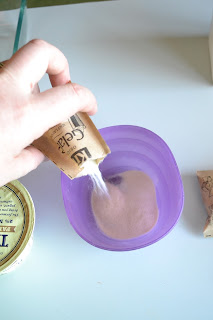Active Ingredients: Any component that provides pharmacological activity or other direct effect in the diagnosis, cure, mitigation, treatment, or prevention of disease, or affects the structure or any function of the body of man or animals.
Neomycin: is an antibiotic that's used to prevent or treat bacterial infections.
Polymyxin B: is an antibiotic primarily used for resistant gram negative infections
Bacitracin: is an antibiotic that stops the growth of certain bacteria.
Inactive ingredients: the ingredients that do not exert the intended therapeutic effect, and do not cause the side effects, known or unknown, associated with the particular drug. (they can very from name brand to generic brand, but for this purposed I am looking at a well known name brand)
Cocoa Butter: After Coco beans are cleaned, they are roasted and then pressed in hydraulic machinery, oozing forth cocoa butter
Cottonseed Oil: is a cooking oil extracted from the seeds of cotton plants. (High chance this is from a GMO crop)
Olive Oil: Olive oil the oil obtained from the fruit of olive trees.
Sodium Pyruvate: "is added to many media formulations as a carbohydrate source that cells can easily access for energy production."
White Petrolatum: Distilled from petroleum.
Umm.....Not sure about you, but I only like two of those eight ingredients. So now that you have seen what's in a triple antibiotic ointment, what's the simple mix I use for cuts and scrapes?
Thieves Oil and Coconut oil. Yen, it doesn't get much simpler then that!
Thieves oil is a blend of 5 essential oils: Lemon, Clove bud, Eucalyptus, Cinnamon and Rosemary. Different companies use different plant species to make their own blends, so when selecting your thieves oil, that is something to keep in mind. Also keep in mind that it may not be called "thieves oil." One company calls their blend "germ fighter." You can also make your own thieves mix by buying a vial of each of the above listed oils and mixing them. I found this recipe over at No Ordinary Homestead to share with you. If you want to make it a concentrate, just leave off the Jojoba oil, and use the drop amount she has listed for each essential oil.
How do you make the Scratch and Scrape salve? Well you need four things:
*Coconut Oil:
*Thieves Oil blend: (always test a small amount on your skin to make sure you do not have an allergic reaction. Just because these are natural doesn't mean you wont react to them, and never apply full strength to your skin. Always apply a diluted mix of carrier oil and essential oil)
*Small glass jar: If you don't want to but them, use a baby food jar! I actually have an entire tub of them from when my daughter was a wee babe. The jars from the meats are a bit smaller, and work the best for small batch items like this. (Yes use glass, because while essential oils are natural plant extracts they are still chemicals and can react with plastic)
*Toothpick.
Put 1 tablespoon of coconut oil in the jar, then add three drops of thieves oil blend. I use the toothpick to mix it up. Put the cap on and your done! Seriously easy right?
And for those of you who are interested in learning more about essential oils, go see my girl over at The Oily Empire. She has been doing pod casts that talk about different oils, what they are good for, how to use them. She is also very responsive on her Facebook page, plus she is a total sweetheart! Here are links to her podcasts through iTunes and Google Play (just click the name and it will take you there!)
There are also quite a few studies of essential oils and their antibacterial properties, if you know where to look. Here is one for Clove that I was able to locate. I will update and add more links for the other oils listed in this post, as I find them.
This article does contain affiliate links.







































